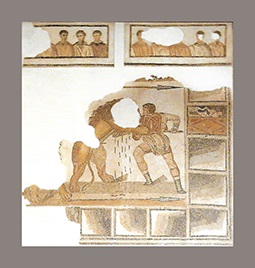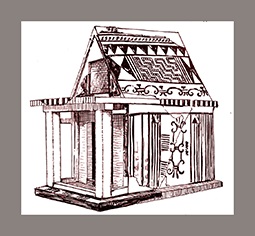Autore: L. Polidoro
Scarica l’articolo in formato.pdf: Le decorazioni in pietre e marmi negli anfiteatri romani. Forme, distribuzione e colori
 Gli anfiteatri romani erano spesso dotati di decorazioni realizzate in pietre e marmi, ma ad oggi la loro analisi non è stata sempre approfondita in tutte le sue sfaccettature. In particolare, le conoscenze relative a lastre di rivestimento parietale e pavimentale sono molto sommarie e talvolta anche specifiche soluzioni architettoniche, come gli ingressi principali e le porticus in summa cavea, sono trattate in maniera piuttosto cursoria. Il presente studio intende esaminare questi apparati decorativi e mostrarne l’importanza per la comprensione dei monumenti, dal momento che essi contribuivano significativamente a costruire l’immagine degli edifici apprezzabile dagli spettatori antichi. Si deve sottolineare la loro importanza nella resa del carattere policromo delle architetture, sia mediante il colore naturale dei materiali sia attraverso integrazioni in pittura. Inoltre, la presenza di decorazioni in pietre e marmi sottolineava alcuni settori degli anfiteatri, come le tribune d’onore e i luoghi di culto, valorizzando chi li frequentava e le attività che vi si svolgevano: esse, quindi, contribuivano a definire a livello sociale e funzionale gli spazi.
Gli anfiteatri romani erano spesso dotati di decorazioni realizzate in pietre e marmi, ma ad oggi la loro analisi non è stata sempre approfondita in tutte le sue sfaccettature. In particolare, le conoscenze relative a lastre di rivestimento parietale e pavimentale sono molto sommarie e talvolta anche specifiche soluzioni architettoniche, come gli ingressi principali e le porticus in summa cavea, sono trattate in maniera piuttosto cursoria. Il presente studio intende esaminare questi apparati decorativi e mostrarne l’importanza per la comprensione dei monumenti, dal momento che essi contribuivano significativamente a costruire l’immagine degli edifici apprezzabile dagli spettatori antichi. Si deve sottolineare la loro importanza nella resa del carattere policromo delle architetture, sia mediante il colore naturale dei materiali sia attraverso integrazioni in pittura. Inoltre, la presenza di decorazioni in pietre e marmi sottolineava alcuni settori degli anfiteatri, come le tribune d’onore e i luoghi di culto, valorizzando chi li frequentava e le attività che vi si svolgevano: esse, quindi, contribuivano a definire a livello sociale e funzionale gli spazi.
Roman amphitheatres usually had marble and stone decorations, but, as of today, their analysis is quite incomplete. In particular, wall and pavement revetement slabs have often been simplified and sometimes even architectural elements, such as the monumental entrances and the porticus in summa cavea, have been overlooked. This present study intends to examine these decorations and underline their importance for the understanding of monuments, since they contributed significantly in the imagine perceived by ancient viewers. Marble and stone ornamentations were also important to determine the polychromatic character of the architectures, both by means of the materials natural colours as well as painted integrations. Furthermore, their presence highlighted specific sectors of the buildings (such as the authorities’ tribune and cult places) and, consequently, the people and the activities there hosted. Hence, they contributed to create the hierarchy of social and functional places.

